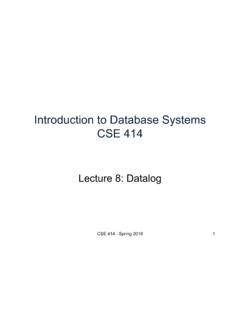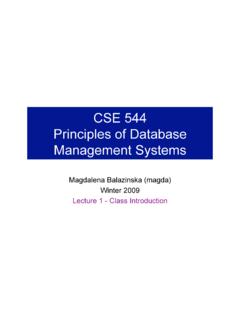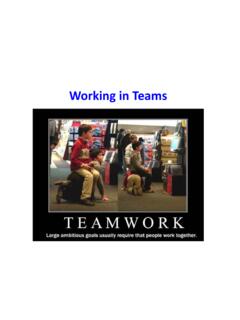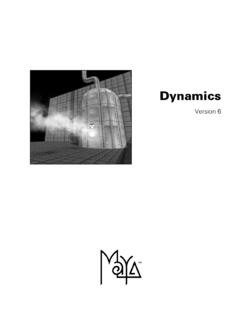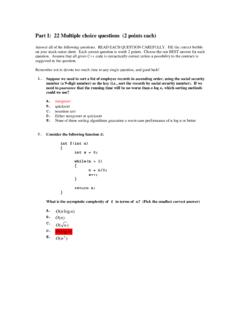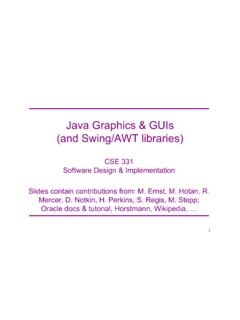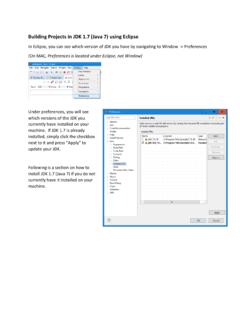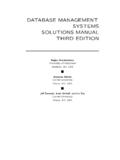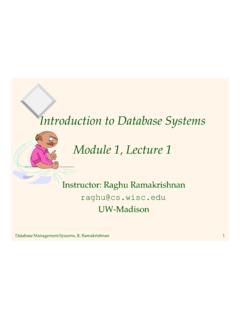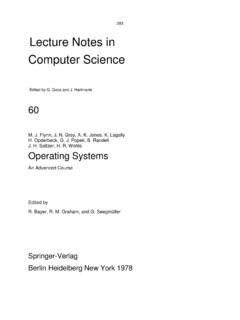Transcription of Introduction to Database Systems CSE 444
1 Introduction to Database Systems CSE 444 Lectures 11-12 Transactions: Recovery (Aries) Magda Balazinska - CSE 444, Fall 2010 1 Readings Material in today s lecture NOT in the book Instead, read Sections 1, , and of: Michael J. Franklin. Concurrency Control and Recovery. The Handbook of Computer Science and Engineering, A. Tucker, ed., CRC Press, Boca Raton, 1997. Magda Balazinska - CSE 444, Fall 2010 2 Transaction Management Two parts: Recovery from crashes: ACID Concurrency control: ACID Both operate on the buffer pool Our current focus: recovery Magda Balazinska - CSE 444, Fall 2010 3 Buffer Manager Disk Main memory Page requests from higher-level code Buffer pool Disk page Free frame 1 page corresponds to 1 disk block Disk = collection of blocks Disk space manager Buffer pool manager Files and access methods 4 READ WRITE INPUT OUTUPT choice of frame dictated by replacement policy Data must be in RAM for DBMS to operate on it!
2 Buffer pool = table of <frame#, pageid> pairs Magda Balazinska - CSE 444, Fall 2010 5 Buffer Manager Policies STEAL or NO-STEAL Can an update made by an uncommitted transaction overwrite the most recent committed value of a data item on disk? FORCE or NO-FORCE Should all updates of a transaction be forced to disk before the transaction commits? Easiest for recovery: NO-STEAL/FORCE Highest performance: STEAL/NO-FORCE Comparison Undo/Redo Undo logging: OUTPUT must be done early If <COMMIT T> is seen, T definitely has written all its data to disk (hence, don t need to redo) inefficient Redo logging OUTPUT must be done late If <COMMIT T> is not seen, T definitely has not written any of its data to disk (hence there is not dirty data on disk, no need to undo) inflexible Would like more flexibility on when to OUTPUT: undo/redo logging (next) Magda Balazinska - CSE 444, Fall 2010 Steal/Force No-Steal/No-Force Steal/No-Force 6 Aries Recovery Algorithm An UNDO/REDO log with lots of clever details 7 Magda Balazinska - CSE 444, Fall 2010 8 Write-Ahead Log Enables the use of STEAL and NO-FORCE Log.
3 Append-only file containing log records For every update, commit, or abort operation Write physical, logical, or physiological log record (more later) Note: multiple transactions run concurrently, log records are interleaved After a system crash, use log to: Redo some transaction that did commit Undo other transactions that didn t commit Magda Balazinska - CSE 444, Fall 2010 9 Write-Ahead Log All log records pertaining to a page are written to disk before the page is overwritten on disk All log records for transaction are written to disk before the transaction is considered committed Why is this faster than FORCE policy? Committed transaction: transactions whose commit log record has been written to disk Magda Balazinska - CSE 444, Fall 2010 Granularity in ARIES Page-oriented logging for REDO (element=one page) Logical logging for UNDO (element=one record) Result: logs logical operations within a page This is called physiological logging Why this choice?
4 Must do page-oriented REDO since cannot guarantee that db is in an action-consistent state after crash Must do logical undo because ARIES will only undo loser transactions (this also facilitates ROLLBACKs) 10 Magda Balazinska - CSE 444, Fall 2010 11 ARIES Method Recovery from a system crash is done in 3 passes: 1. Analysis pass Figure out what was going on at time of crash List of dirty pages and active transactions 2. Redo pass (repeating history principle) Redo all operations, even for transactions that will not commit Get back to state at the moment of the crash 3. Undo pass Remove effects of all uncommitted transactions Log changes during undo in case of another crash during undo Magda Balazinska - CSE 444, Fall 2010 12 ARIES Method Illustration [Franklin97] May be in reverse order Magda Balazinska - CSE 444, Fall 2010 13 ARIES Data Structures Active Transactions Table Lists all running transactions (active transactions) For each txn: lastLSN = most recent update by transaction Dirty Page Table Lists all dirty pages For each dirty page.
5 RecoveryLSN (recLSN)= first LSN that caused page to become dirty Write Ahead Log contains log records LSN, prevLSN = previous LSN for same transaction other attributes Magda Balazinska - CSE 444, Fall 2010 ARIES Data Structures 14 pageID recLSN P5 102 P6 103 P7 101 LSN prevLSN transID pageID Log entry 101 - T100 P7 102 - T200 P5 103 102 T200 P6 104 101 T100 P5 Dirty pages Log transID lastLSN T100 104 T200 103 Active transactions P5 PageLSN=104 P6 PageLSN=103 P7 PageLSN=101 Buffer Pool The LSN Each log entry receives a unique Log Sequence Number, LSN The LSN is written in the log entry Entries belonging to the same transaction are chained in the log via prevLSN LSN s help us find the end of a circular log file: 15 After crash, log file = (22, 23, 24, 25, 26, 18, 19, 20, 21) Where is the end of the log ? 18 Magda Balazinska - CSE 444, Fall 2010 16 ARIES Method Details Steps under normal operations Add log record Update transactions table Update dirty page table Update pageLSN Magda Balazinska - CSE 444, Fall 2010 ARIES Method More details and long example on the board Please TAKE NOTES!
6 Magda Balazinska - CSE 444, Fall 2010 17 18 Checkpoints Write into the log Entire active transactions table Entire dirty page table Very fast ! No waiting, no END CKPT But, effectiveness is limited by dirty pages There is a background process that periodically sends dirty pages to disk Magda Balazinska - CSE 444, Fall 2010 19 1. Analysis Phase Goal Determine point in log where to start REDO Determine set of dirty pages when crashed Conservative estimate of dirty pages Identify active transactions when crashed Approach Rebuild active transactions table and dirty pages table Reprocess the log from the beginning (or checkpoint) Only update the two data structures Compute: firstLSN = smallest of all recoveryLSN Magda Balazinska - CSE 444, Fall 2010 1. Analysis Phase Magda Balazinska - CSE 444, Fall 2010 20 (crash) Checkpoint Dirty pages Active transactions Log Replay history firstLSN 2.
7 Redo Phase Main principle: replay history Process Log forward, starting from firstLSN Read every log record, sequentially Redo actions are not recorded in the log Needs the Dirty Page Table Magda Balazinska - CSE 444, Fall 2010 21 22 2. Redo Phase: Details For each Log entry record LSN If affected page is not in Dirty Page Table then do not update If recoveryLSN > LSN, then no update Read page from disk; If pageLSN > LSN, then no update Otherwise perform update Magda Balazinska - CSE 444, Fall 2010 3. Undo Phase Main principle: logical undo Start from the end of the log, move backwards Read only affected log entries Undo actions are written in the Log as special entries: CLR (Compensating Log Records) CLRs are redone, but never undone Magda Balazinska - CSE 444, Fall 2010 23 3. Undo Phase: Details Loser transactions = uncommitted transactions in Active Transactions Table ToUndo = set of lastLSN of loser transactions While ToUndo not empty: Choose most recent (largest) LSN in ToUndo If LSN = regular record: undo; write a CLR where = ; if not null, insert in ToUndo otherwise, write <END TRANSACTION> in log If LSN = CLR record: (don t undo !)
8 If not null, insert in ToUndo otherwise, write <END TRANSACTION> in log Magda Balazinska - CSE 444, Fall 2010 24 25 Handling Crashes during Undo [Figure 4 from Franklin97] Magda Balazinska - CSE 444, Fall 2010
